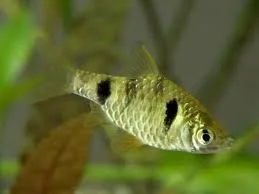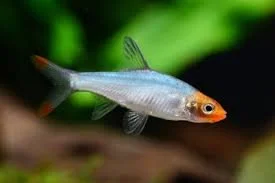 Image 1 of 1
Image 1 of 1


Barb- Rosy Longfin
The longfin rosy barb is a peaceful, active, schooling fish known for its vibrant rosy-red color (in males) and long, flowing fins. They are hardy and beginner-friendly, growing up to 4-6 inches, and are best kept in groups of at least 5-6 in a 30-gallon tank or larger. Males are more brightly colored, while females are mostly yellow.
Appearance
Size: Grows up to 4-6 inches (10-15 cm).
Color: Males have vibrant rosy-red and gold coloration, while females are more golden. Sunlight can enhance their colors.
Fins: The longfin variety features long, flowing fins that become more pronounced as they grow.
Temperament and behavior
Temperament: Peaceful and active.
Social Behavior: They are schooling fish and should be kept in groups of at least 5-6 to thrive and reduce stress.
Tank Mates: Compatible with other similar-sized, active, non-fin-nipping fish. Avoid housing them with long-finned species or guppies.
Care requirements
Tank Size: A minimum of a 30-gallon tank is recommended for a group.
Water Temperature: Prefers cooler water, with a range of 64−75∘F (18−24∘C). They can even be kept in unheated tanks or outdoor ponds in warmer climates.
Water Conditions: Tolerates a pH of 6.0-8.0 and soft to moderately hard water.
Diet: Omnivorous and not picky eaters; they will eat flakes, pellets, and frozen foods like bloodworms and brine shrimp.
Plants: They may nibble on plants, so choose hardy species like Anubias or Java moss, and avoid soft-leaved varieties.
The longfin rosy barb is a peaceful, active, schooling fish known for its vibrant rosy-red color (in males) and long, flowing fins. They are hardy and beginner-friendly, growing up to 4-6 inches, and are best kept in groups of at least 5-6 in a 30-gallon tank or larger. Males are more brightly colored, while females are mostly yellow.
Appearance
Size: Grows up to 4-6 inches (10-15 cm).
Color: Males have vibrant rosy-red and gold coloration, while females are more golden. Sunlight can enhance their colors.
Fins: The longfin variety features long, flowing fins that become more pronounced as they grow.
Temperament and behavior
Temperament: Peaceful and active.
Social Behavior: They are schooling fish and should be kept in groups of at least 5-6 to thrive and reduce stress.
Tank Mates: Compatible with other similar-sized, active, non-fin-nipping fish. Avoid housing them with long-finned species or guppies.
Care requirements
Tank Size: A minimum of a 30-gallon tank is recommended for a group.
Water Temperature: Prefers cooler water, with a range of 64−75∘F (18−24∘C). They can even be kept in unheated tanks or outdoor ponds in warmer climates.
Water Conditions: Tolerates a pH of 6.0-8.0 and soft to moderately hard water.
Diet: Omnivorous and not picky eaters; they will eat flakes, pellets, and frozen foods like bloodworms and brine shrimp.
Plants: They may nibble on plants, so choose hardy species like Anubias or Java moss, and avoid soft-leaved varieties.






